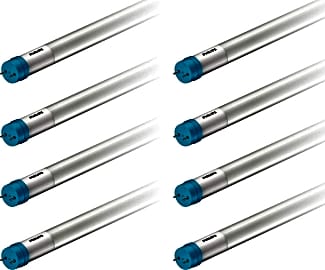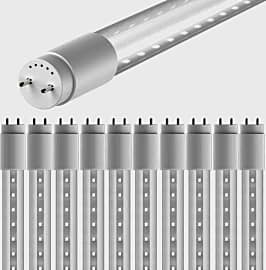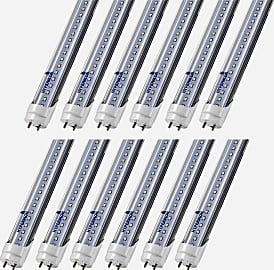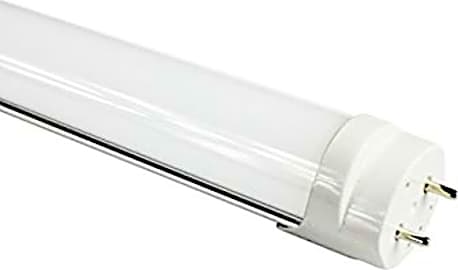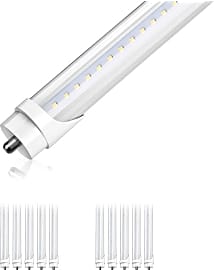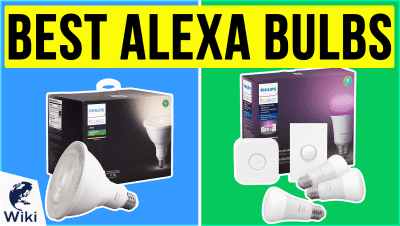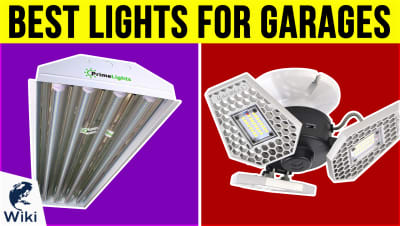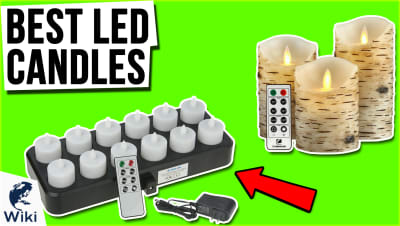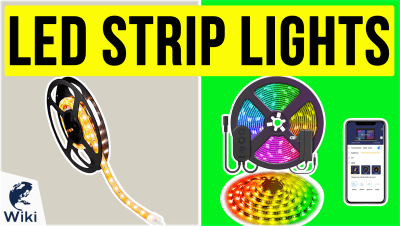The 10 Best LED Tube Lights

This wiki has been updated 36 times since it was first published in October of 2017. While fluorescent bulbs were often the choice for offices and workshops in the past, LED tubes now offer benefits that can't be matched by any other technology. They turn on instantly, use little power, and produce more lumens than alternatives, and they don’t flicker or hum. You can choose plug-and-play options as well as hardwired ones that require installation by a licensed electrician. When users buy our independently chosen editorial selections, we may earn commissions to help fund the Wiki.
Editor's Notes
December 03, 2020:
The GE 35896 makes its way onto the list in this update, and these six tubes serve as reliable, easy-to-install replacements for linear fluorescent light bulbs. Unlike some others, they’re compatible with either instant- or programmed-start ballasts, and they’re available in your choice of bright white, cool white, daylight, warm white, or sunshine color temperatures. We also added the Philips InstantFit T8, which are also a relatively easy way to replace old fluorescent bulbs, and they work well with most instant-start ballasts. They’re Energy Star certified and free of mercury, and have a rated lifespan of up to 36,000 hours, based on an estimate of three hours of use per day. Their bright, crisp illumination makes them a good option for project and task lighting, as well as placement in large spaces. They’re from a popular name in lighting that’s been around for well over a century. The Parmida T8 also come on board, as a set of 10 that each features a protective shatterproof coating, a frosted lens, and an FA8 single-pin base. This energy-efficient choice is eligible for state and nationwide rebate programs. Leaving the list to make way for these three new additions are the Zoopod Frosted, the Luceco L36, and the Hykolity Ballast Bypass.
For another durable selection from a well-known name in lighting, check out the Sunco Lighting 10-Pack which, unlike many, eliminate the need for a ballast. They won’t flicker or buzz, come with a helpful DIY installation guide, and provide a generous 120-beam angle to help light up a large area. They’re tested thoroughly for optimal performance and are backed by a generous 5-year warranty. The Hyperikon U-Bent stand out from the rest of the pack, thanks to their distinctive U-shape design. Their high output of 2,000 lumens makes them a good choice when you need a bright light for garage, workshop, or office use. For a safe and proper setup, any light that requires hardwiring should be installed by a licensed electrician.
January 31, 2019:
Investigated claims that the Sunco Lighting model does not work with a ballast as claimed; for most, it indeed does not, but it remains a viable option as a single-end ballast-bypass install. Removed the Shine Hai SGL due to availability issues and added the HouLight T8 Replacement, which is only available in packs of 25 but is a good value for those who need this larger quantity.
Seeing The Light
Those looking to swap them for a more efficient alternative often look to LEDs.
If you spend your days slaving away in an office, chances are you’re familiar with the maddening effect a flickering fluorescent light can have. It’s distracting enough to decrease your productivity, and plays tricks on your eyes that can make you feel like you’re losing your mind. While fluorescents offer a marked improvement over incandescent lighting sources, they still have a handful of drawbacks and irritating attributes. Those looking to swap them for a more efficient alternative often look to LEDs. So, without further ado, here are a few reasons why you should make the switch.
Fluorescent lights require a high voltage pulse to turn on, and then something to regulate their current to prevent them from burning out. Older fixtures use a starter, which is a tiny metallic cylinder that sends a jolt of current through the lamp to ionize the gas within, enabling it to conduct the electricity required to produce visible light. Modern fluorescents use devices called ballasts to regulate their current and provide that initial electrical burst. The ionization process usually takes a few seconds, hence the characteristic delay when you flip the switch to turn them on.
Exposure to extreme temperatures and high-humidity climates can force these mechanisms to wear down and corrode over time, which is what accounts for that annoying humming and flickering. Unless you can do it yourself, replacing them can be a costly affair. Most LEDs don’t require a ballast and are actually capable of bypassing it completely. Not only does this save energy and keep your maintenance costs down, but it also eliminates the creepy, horror movie-like conditions that come part and parcel with fluorescent tubes.
You’ll also benefit from a lower electricity bill if you retrofit your fixtures with LED tubes. LEDs use less wattage than conventional fluorescents and end up being at least 30 percent more efficient. They have around double the lifespan and don't contain mercury, so they’re much easier to dispose of when they do eventually die. They surpass their fluorescent cousins when it comes to lighting performance, as well. An LED distributes light directly to its intended target, rather than the 360-degree angle pattern that a fluorescent achieves. They’re available in a range of color temperatures and don’t emit UV light, which can fade signs and upholstery and cause unnecessary eye strain.
What To Look For In An LED Tube Light
Choosing the right LED tube light can be confusing and overwhelming when you don’t know where to begin. Whether you’re retrofitting existing fixtures in a warehouse or just looking to install a few in your home, there are two major considerations you’ll want to prioritize when weighing your choices.
Bear in mind, though, that the latter option will not absolve you of the extra expense and headaches that come saddled with ballasts.
To start, you’ll have to determine whether your new tubes will need to bypass or be compatible with an existing ballast system. If you’re looking to outfit a large facility and your goal is to reduce energy consumption and maintenance costs, you’ll want to opt for direct wire lights that require special installation. If you’d prefer the simplest fitting possible, go for ballast-compatible lights that can be put in with no fuss. Bear in mind, though, that the latter option will not absolve you of the extra expense and headaches that come saddled with ballasts.
You'll also want to settle on your ideal color temperature. This refers to the different shades of white light your tubes will emit, and there are three primary types — soft white, cool white, and daylight. Traditional incandescent bulbs boast a cozy, yellowish soft white glow, while many LED tubes are capable of producing all three varieties. Daylight options throw off a bluish, natural light that's excellent for reading and working on projects, while cool white is a neutral version that's a little less intense. If you're worried about glare, you can purchase frosted selections that will illuminate your space while still going easy on the eyes.
The Birth Of LEDs
Believe it or not, LEDs have been in the works for nearly as long as incandescent light bulbs have. It began with the discovery of electroluminescence, a phenomenon in which a material emanates light in reaction to electric current. It was first observed in 1907 by an English engineer and personal assistant to Guglielmo Marconi named Captain Henry Joseph Round. He applied 10 volts of electricity to two silicon carbide contacts and noticed they emitted a yellowish glow. It was much too faint to be practical, and no further experimentation was conducted until the 1920s.
They initially saw employment in the automotive field as brake and traffic lights.
While Captain Round had simply observed and reported on electroluminescence, it was Russian inventor Oleg Losev who conducted further research into the concept. He, too, noticed that when direct current passed through silicone carbide it emitted a spot of light at the contact point, and he constructed the first light-emitting diode, or LED, in 1927. Losev published over a dozen papers on its potential applications over the following years and even proposed a theory about what perpetuated the phenomenon.
The next few decades saw a handful of scientists tinkering with different materials and various ways to produce electroluminescence. Throughout the 1950s and 1960s, engineers were able to construct LEDs that emitted infrared light, making them viable for the telecommunications sector. By 1962, General Electric employee Nick Holonyak Jr. developed an LED that generated visible red light.
The first commercially-used LEDs were fit only to replace incandescent indicator lights in expensive laboratory equipment. As the cost to manufacture them diminished, they began to see use in everyday appliances like televisions and calculators. They were still too dim to illuminate an area, but indefatigable development eventually led to high-brightness LEDs radiant enough for the lighting industry. They initially saw employment in the automotive field as brake and traffic lights. Producers were able to create red, blue, and green LEDs before finally innovating a vibrant white variant that could serve as a lighting source within homes and offices.
Because of their efficiency and long lifetime, LEDs are well on their way to supplanting fluorescent and incandescent lights. They've made their way into everything from computer monitors to imitation candles, and the technology continues to improve.


